
Watchmen is a comic book limited series by the British creative team of writer Alan Moore, artist Dave Gibbons and colorist John Higgins. It was published monthly by DC Comics in 1986 and 1987 before being collected in a single-volume edition in 1987. Watchmen originated from a story proposal Moore submitted to DC featuring superhero characters that the company had acquired from Charlton Comics. As Moore's proposed story would have left many of the characters unusable for future stories, managing editor Dick Giordano convinced Moore to create original characters instead.
The Jack Kirby Comics Industry Awards were a set of awards for achievement in comic books, presented from 1985 to 1987. Voted on by comic-book professionals, the Kirby awards were the first such awards since the Shazam Awards ceased in 1975. Sponsored by Amazing Heroes magazine, and managed by Amazing Heroes managing editor Dave Olbrich, the Kirby Awards were named after the pioneering writer and artist Jack Kirby.

Brian Bolland is a British comics artist. Best known in the United Kingdom as one of the Judge Dredd artists for British comics anthology 2000 AD, he spearheaded the 'British Invasion' of the American comics industry, and in 1982 produced the artwork alongside author Mike W. Barr on Camelot 3000, which was DC Comics' first 12-issue comicbook maxiseries created for the direct market.

David Chester Gibbons is an English comics artist, writer and sometimes letterer. He is best known for his collaborations with writer Alan Moore, which include the miniseries Watchmen and the Superman story "For the Man Who Has Everything". He was an artist for 2000 AD, for which he contributed a large body of work from its first issue in 1977.
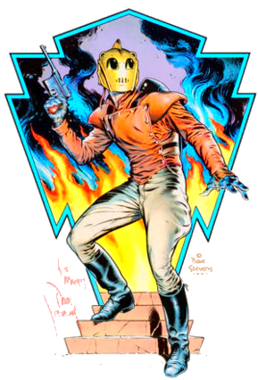
The Rocketeer is a comic book superhero, created by writer/artist Dave Stevens. The character first appeared in 1982 and is an homage to the Saturday matinee serial heroes from the 1930s through the 1950s.

Airboy is a fictional Golden Age aviator hero of an American comic book series initially published by Hillman Periodicals during the World War II, before ending his initial run in 1953. The hero was the costumed identity of crack pilot Davy Nelson II, and created by writers Charles Biro and Dick Wood with artist Al Camy.

Eclipse Comics was an American comic book publisher, one of several independent publishers during the 1980s and early 1990s. In 1978, it published the first graphic novel intended for the newly created comic book specialty store market. It was one of the first to offer royalties and creator ownership of rights.
The Eagle Awards were a series of British awards for comic book titles and creators. They were awarded by UK fans voting for work produced during the previous year. Named after the UK's seminal boys' comic Eagle, the awards were launched in 1977 for comics released in 1976.
Characters native to the African continent have been depicted in comics since the beginnings of the modern comic strip. Initially, such early 20th-century newspaper comics as Winsor McCay's Little Nemo depicted the racist stereotype of a spear-carrying cannibal, a comedic convention of the time. African characters later began to appear as another stereotype, the "noble savage"—a similar progression to that of depictions of Native Americans—and eventually as standard human beings.
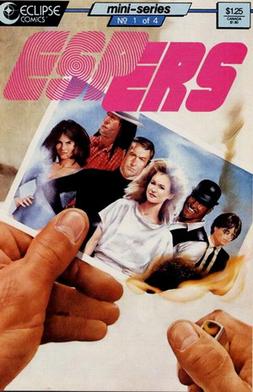
Espers is a creator-owned American science fiction/superhero comic book series created and written by James D. Hudnall. It centers on a disparate group of people with various psychic powers who are brought together under duress and later coalesce as a team. The series was first published by Eclipse Comics in 1985, and most recently published by Image Comics in 1998.

The New Wave was a superhero team comic book published between 1986 and 1987 by Eclipse Comics.
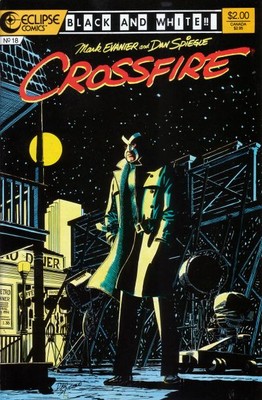
Crossfire is an American comic book series created by writer Mark Evanier and artist Dan Spiegle originally for Eclipse Comics. It was a spin-off from DNAgents, which was also written by Evanier. The series ran for 26 issues from May 1984 to October 1988.
Black people have been portrayed in comics since the medium's beginning, with their portrayals often the subject of controversy. Mainstream comic publishing companies have had a historical trend of being predominantly white and male, reflecting the lack of representation and inaccurate depictions of Black people in comics. The integration of black characters in mainstream and superhero comics has endured various obstacles and challenges. Critics have noted that black men and women have historically often been portrayed as jungle or ghetto stereotypes, and as sidekicks as opposed to primary characters. Occiasionally, comic book creators would lampshade stereotypes, lack of representation and emphasize social injustices. In recent years, with the integration of more Black people in mainstream comic writing rooms as well as the creation of comics on digital platforms has changed the representation and portrayals of Black people in comics and has started to reflect the complexities of Black people across the diaspora.
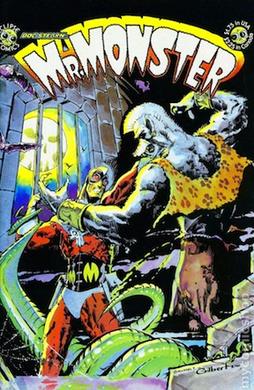
Doc Stearn...Mr. Monster is a comic book featuring a superhero created by Michael T. Gilbert, most recently published by Dark Horse Comics.
Excalibur is the name of several superhero comic books published by Marvel Comics since 1988, generally featuring the team of the same name.

Strike! is an American creator-owned superhero comic book series created by writer Chuck Dixon and artist Tom Lyle, published by Eclipse Comics between 1987 and 1988. It concerns about a teenage boy who finds the power harness of Sgt. Strike, a hero that fought for the US in World War II before disappearing.
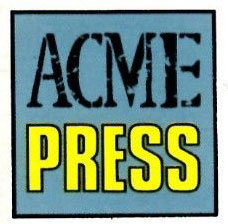
Acme Press Ltd., later known as Acme Comics, was a British comic book publisher active from 1986 to 1995. The company's initial publication was Speakeasy, a monthly fanzine of comics news and criticism. Acme published a number of licensed comics featuring the British espionage properties James Bond and The Avengers. The company also published early work by popular British creators like Alan Moore, Brian Bolland, and Warren Pleece, and it published English translations of some European comics. In the latter half of its existence, Acme formed relationships with American independent publishers Eclipse Comics and Dark Horse Comics, enabling Acme's comics to be distributed in the United States.












